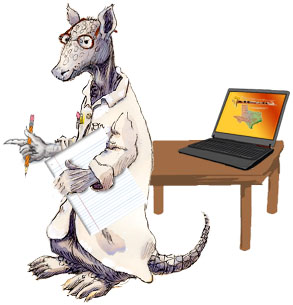Step 3: |
|
| Okay, you have written you paper. You've read it over again (several times) to check spelling, punctuation, and grammar. |  |
| The last thing you must do is tell your reader where you got your information. This consists of a list at the end of your paper. | |
| This list is known by many names including the terms Sources, Bibliography, References, Works Cited, Works Consulted, and many more. | |
| Here, we will use the terms Works Consulted and Works Cited A Works Consulted list should contain all of the sources, such as books, articles in magazines, or Internet pages you consulted to learn about your topic. A Works Cited list should contain all of the sources you "quoted" in you paper. You will probably have both. The list is then titled: Works Cited and Consulted. |
| Format: |
| When writing out entries on your list, use a specific format. There are many formats to choose from. Your teacher will tell you which style is preferred for you assignment. You can find many examples on the Web. Pay close attention to the punctuation: the periods, semi-colons, and underline should be consistent in each. They are highlighted in red to help you see them better. |
For a web site (you may not have access to everything on this list so provide as much information as you can) Author's last name, first name."Title of web page or article ." Title of web site it came from underlined. Editor's name. date last modified or version number. Name of sponsoring institution. Date you accessed this site. <the URL where you found it>. Here's an example of how to cite a page from Texas Beyond History, where there is an author (look in the Credits and Sources section of the web page exhibit or exhibit section). In this example, the page is called Kiowa, and it is in the Native Peoples section of Plateaus and Canyonlands exhibit.
Here's an example of how you would cite a page from Texas Beyond Hisory, where there is no author given:
|
| This is an example of the MLA style, a very common style in use today.
Pay close attention to the punctuation: the periods, semi-colons, and underline should be consistent in each. They are highlighted in red to help you see them better. |
For a book: example: |
| For an Article Author's Last name, First name."Article title in quotation marks." Title of the magazine or periodical it came from underlined. vol#.Issue# (publication date in perethesis): page#s. example: |
|
Notice the reverse indentation pictured in the examples. The first line of each entry is not indented but the following lines are. The last step is to put all of you entries in alphebetical order according to the author's last name. |
| If you have done this list correctly, your reader should be able to see a citation in your paper, find the corresponding entry in your Works Cited and Consulted list, and be able to find the exact resource you used to do your research. |
| Congratulations! You have finished your paper! Now put your name on it and turn it in! |
Texas Beyond History |
|




